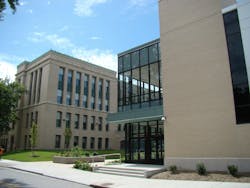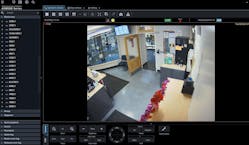By John Dobberstein, Editor
Upgrading aging, entrenched security technology at a large school district is never an easy task, and the story has been the same with the Buffalo (N.Y.) Public School District.
BPSD serves more than 28,000 K-12 students at 70 locations. Security System Engineer John Waterhouse has been overseeing security hardware at every site for more than a decade.
This included more than 5,000 cameras, along with the associated recorders, monitors and PCs, and card access and intercom systems.
The district got by for decades with NVR infrastructure at every building and older-but-reliable Panasonic surveillance cameras. But when the recording platform provider stopped supporting the hardware, and the camera technology became more outdated by the year, BPSD had no choice but to modernize.
“We needed to move to a platform that would be compatible with these older cameras while enabling us to move into the future as well,” Waterhouse says.
“When you look at K through 12 schools, you're looking at more of a reactionary response in most cases. The AI technology we have now lets them into a more proactive approach with alarms and alerts,” says Nick Toth, Director of Sales for the Americas.
Pinpointing Needs
Taking advantage of $2 billion in bond money available through the state for security upgrades, the school district conducted an extensive study to weigh enterprise-wide security options. BPSD wanted a more centralized setup that would allow them to expand on the servers they were running.
Rapid advancements in camera technology prompted Waterhouse to extend their initial modernization project to include cameras as well as new recording systems -- primarily because certain camera deployments were limited in their field of view, causing security teams to miss some events and incidents.
Administrators determined the camera/NVR infrastructure served their needs and budget best due to its ease of use, price point and ability to reduce hardware footprint in all their buildings. The board of education awarded the contract to I-PRO, since the Panasonic cameras had proven to be very reliable.
“When they looked at the total i-PRO solution compared to the cost of the reoccurring pricing models, it was hard to say no,” Toth surmised. “And they got the feature sets that they were looking for. They didn't need all the expanded bells and whistles, especially coming from what they had there.
“They also have many, many different types of users,” he adds, “and they were concerned that some of them might get lost with the more complex enterprise solutions.”
Swapping Out
BPSD modernized the entire district’s security footprint by first replacing 2% of their older interior PTZ cameras with i-PRO 5MP fisheye network cameras with 360-degree coverage, while swapping out obsolete recorders with i-PRO NV300 NVRs.
Through several phases, BPSD upgraded 15% and then a further 60% of their older cameras with new i-PRO vandal-resistant dome cameras, additional fisheye cameras, and strategically placed multi-sensor cameras for building exteriors and common gathering places.
Additional NVRs were upgraded to the newest i-PRO NX400 recorders running i-PRO ASM300 monitoring software.
The cameras are connected at a HUB site consisting of 10 schools via a 10-gigabyte link for each school. The HUB is connected in a ring formation running at 40 gigabytes.
Each school location has a main office PC and a security PC running ASM300 for real-time monitoring. There are also additional PC locations at each school to allow school staff to monitor the system as required. The main location includes several PCs watching over the entire district and supplies technical support and archiving of footage as needed.
“I wanted one monitoring point for the hardware – everything from all of our ASM 300 software instances in a one-map scenario,” says Waterhouse. “To do that I had to accommodate a lot of maps and users. We worked on adding groups and maps to the software so we could have more than the standard offering. Now we can do up to 500 maps on our system.
“Each floor is a map with cameras. A lot of people in our district are more picture-oriented, so having maps with cameras makes it much easier for people to navigate to them.”
Waterhouse also pointed to a critical but important benefit to modernizing with a solution that builds in cybersecurity by design. “The district recently had a ransomware attack, and the i-PRO cameras and recording system were immune to the attack. It performed flawlessly throughout the event,” he says.
“An advantage to updating to i-PRO fisheye cameras is that in hallways where schools had two cameras to monitor movements, they were able to replace them with a single camera. And results look to be better as well.
“When you have PTZs on a pre-programmed tour they just move along. An incident can happen in one or two seconds, and the system can easily miss it,” Waterhouse says. “Since we didn’t have dedicated resources to control the old PTZs, we elected to replace them with fisheye cameras recording in 360 degrees.
“They capture an event wherever it happens. That’s the biggest benefit and it works better in a school environment where (school resource officers) focus on being present on the grounds. Reducing camera count was a huge benefit not only for our budget but in terms of maintenance, too.”
School security officers are also impressed, Toth says, with the in-camera de-warping feature which delivers clear fisheye, panoramic and de-warped images with an electrical pan-tilt-zoom. “The built-in de-warping gives our teams a lot of flexibility when reviewing video,” Waterhouse notes.
Customizing a Solution
The district is currently studying different technology plans for the cameras, which could include gunshot detection, license-plate recognition, facial recognition and more.
Whatever is chosen, the features are built into the cameras, so there would be no extra license required, Toth says. He adds that attribute search features alone would save school officials time over simply rewinding and reviewing captured video.
BPSD and i-PRO chose to focus strategically on choke points, like main entrances, to have full AI capabilities installed rather than doing the entire system.
“Once they have parameters set, they can go into a more proactive approach. So if there's a sudent or parent that is on a watch list for whatever reason, they would want to attributes or face detection so they receive alarms and alerts before they enter the school,” he says.
“When we showed them the AI capabilities of attribute search, they were almost jumping out of their seats,” Toth says, “because instead of just manually searching, they can build the attribute search rules and the system is going to automatically find every match in a fraction of the time.”
Looking ahead, Waterhouse says he anticipates taking advantage of some of the advanced edge-based AI analytics offered in the i-PRO cameras.
“Object recognition, gunshot detection -- it all depends on what the district decides to pursue. We’re getting demonstrations of what the software can do now. The important thing is, we know the capabilities are there with i-PRO. It’s just a matter of what we want and how we get there.”



